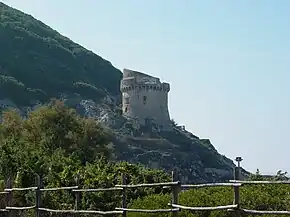Mount Circeo
Monte Circeo or Cape Circeo (Italian: Promontorio del Circeo [promonˈtɔːrjo del tʃirˈtʃɛːo], Latin: Mons Circeius) is a mountain promontory that marks the southwestern limit of the former Pontine Marshes, located on the southwest coast of Italy near San Felice Circeo. At the northern end of the Gulf of Gaeta, it is about 5 kilometres (3.1 mi) long by 1.5 kilometres (0.93 mi) wide at the base, running from east to west and surrounded by the sea on all sides except the north. The land to the northeast is the former ancient Pontine Marshes. Most of the ancient swamp has been reclaimed for agriculture and urban areas.
| Mount Circeo | |
|---|---|
 Mount Circeo as seen from Terracina, Italy | |
| Highest point | |
| Elevation | 541 m (1,775 ft) |
| Prominence | 541 m (1,775 ft) |
| Coordinates | 41°14′00″N 13°03′00″E |
| Geography | |
 Mount Circeo Italy | |
| Location | San Felice Circeo, Lazio, Italy |



The mountain, the coastal zone as far north as Latina, including the only remaining remnant of the swamp, and two of the Pontine Islands offshore, Zannone and Ponza, have been included in the Circeo National Park.
Geology
Although a headland, it was not formed by coastal erosion – as headlands are usually formed – but is a remnant of the orogenic processes that created the Apennines. The entire coast of Lazio, on which the mountain and the marsh are located, was a chain of barrier islands that was formed on a horst and made part of the mainland by sedimentation of the intervening graben.
The mountain is composed mostly of marl and sandstone from the Paleogene and of limestone from the lower Early Jurassic.
Prehistory
In 1939, the skull of a Neanderthal man was found in the Guattari Cave by a team led by Alberto Carlo Blanc. Several other findings also show that the mountain was inhabited in prehistorical times.[1][2] In May 2021, the remains of 9 Neanderthal men were discovered in the same Guattari cave. The Minister of Culture in Italy declared the site to be one of the most significant in the world regarding the Neanderthal period.[3][4]
History
Today
Mount Circeo is today included in the National Park of Circeo, established in 1934 on 5,616 ha (56.16 km2; 13,880 acres; 21.68 sq mi) over the territories of Latina, Sabaudia, San Felice Circeo and Zannone Island (minor island of Ponziane Archipelago).
References
- "Guattari Cave". NESPOS - Pleistocene People and Places. Retrieved 9 January 2020.
- "Guattari Cave - cranium". NESPOS - Pleistocene People and Places. Archived from the original on 9 January 2020. Retrieved 9 January 2020.
- (in French) Les restes de neuf Néandertaliens découverts dans une grotte en Italie, Buzz-europa.com, 19 May 2021
- Elisabetta Povoledo, These Neanderthals Weren’t Cannibals, So Who Ate Them? Stone Age Hyenas., Nytimes.com, 8 May 2021